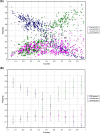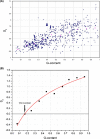Stop codons in bacteria are not selectively equivalent
- PMID: 22974057
- PMCID: PMC3549826
- DOI: 10.1186/1745-6150-7-30
Stop codons in bacteria are not selectively equivalent
Abstract
Background: The evolution and genomic stop codon frequencies have not been rigorously studied with the exception of coding of non-canonical amino acids. Here we study the rate of evolution and frequency distribution of stop codons in bacterial genomes.
Results: We show that in bacteria stop codons evolve slower than synonymous sites, suggesting the action of weak negative selection. However, the frequency of stop codons relative to genomic nucleotide content indicated that this selection regime is not straightforward. The frequency of TAA and TGA stop codons is GC-content dependent, with TAA decreasing and TGA increasing with GC-content, while TAG frequency is independent of GC-content. Applying a formal, analytical model to these data we found that the relationship between stop codon frequencies and nucleotide content cannot be explained by mutational biases or selection on nucleotide content. However, with weak nucleotide content-dependent selection on TAG, -0.5 < Nes < 1.5, the model fits all of the data and recapitulates the relationship between TAG and nucleotide content. For biologically plausible rates of mutations we show that, in bacteria, TAG stop codon is universally associated with lower fitness, with TAA being the optimal for G-content < 16% while for G-content > 16% TGA has a higher fitness than TAG.
Conclusions: Our data indicate that TAG codon is universally suboptimal in the bacterial lineage, such that TAA is likely to be the preferred stop codon for low GC content while the TGA is the preferred stop codon for high GC content. The optimization of stop codon usage may therefore be useful in genome engineering or gene expression optimization applications.
Figures







Similar articles
-
Stop Codon Usage as a Window into Genome Evolution: Mutation, Selection, Biased Gene Conversion and the TAG Paradox.Genome Biol Evol. 2022 Aug 3;14(8):evac115. doi: 10.1093/gbe/evac115. Genome Biol Evol. 2022. PMID: 35867377 Free PMC article.
-
Role of premature stop codons in bacterial evolution.J Bacteriol. 2008 Oct;190(20):6718-25. doi: 10.1128/JB.00682-08. Epub 2008 Aug 15. J Bacteriol. 2008. PMID: 18708500 Free PMC article.
-
Comprehensive analysis of stop codon usage in bacteria and its correlation with release factor abundance.J Biol Chem. 2014 Oct 31;289(44):30334-30342. doi: 10.1074/jbc.M114.606632. Epub 2014 Sep 12. J Biol Chem. 2014. PMID: 25217634 Free PMC article.
-
Refining the Ambush Hypothesis: Evidence That GC- and AT-Rich Bacteria Employ Different Frameshift Defence Strategies.Genome Biol Evol. 2018 Apr 1;10(4):1153-1173. doi: 10.1093/gbe/evy075. Genome Biol Evol. 2018. PMID: 29617761 Free PMC article.
-
Synonymous codon usage in bacteria.Curr Issues Mol Biol. 2001 Oct;3(4):91-7. Curr Issues Mol Biol. 2001. PMID: 11719972 Review.
Cited by
-
Collateral Toxicity Limits the Evolution of Bacterial Release Factor 2 toward Total Omnipotence.Mol Biol Evol. 2020 Oct 1;37(10):2918-2930. doi: 10.1093/molbev/msaa129. Mol Biol Evol. 2020. PMID: 32437534 Free PMC article.
-
ATGC database and ATGC-COGs: an updated resource for micro- and macro-evolutionary studies of prokaryotic genomes and protein family annotation.Nucleic Acids Res. 2017 Jan 4;45(D1):D210-D218. doi: 10.1093/nar/gkw934. Epub 2016 Oct 18. Nucleic Acids Res. 2017. PMID: 28053163 Free PMC article.
-
In eubacteria, unlike eukaryotes, there is no evidence for selection favouring fail-safe 3' additional stop codons.PLoS Genet. 2019 Sep 17;15(9):e1008386. doi: 10.1371/journal.pgen.1008386. eCollection 2019 Sep. PLoS Genet. 2019. PMID: 31527909 Free PMC article.
-
CRISPR-Cas-Guided Mutagenesis of Chromosome and Virulence Plasmid in Shigella flexneri by Cytosine Base Editing.mSystems. 2023 Feb 23;8(1):e0104522. doi: 10.1128/msystems.01045-22. Epub 2022 Dec 21. mSystems. 2023. PMID: 36541764 Free PMC article.
-
Purifying and positive selection in the evolution of stop codons.Sci Rep. 2018 Jun 18;8(1):9260. doi: 10.1038/s41598-018-27570-3. Sci Rep. 2018. PMID: 29915293 Free PMC article.
References
Publication types
MeSH terms
Substances
Grants and funding
LinkOut - more resources
Full Text Sources
Molecular Biology Databases
Miscellaneous

